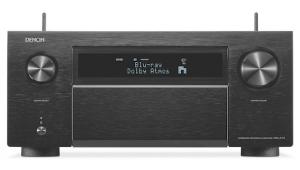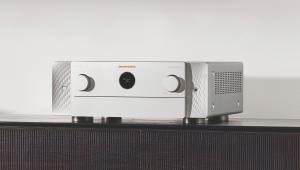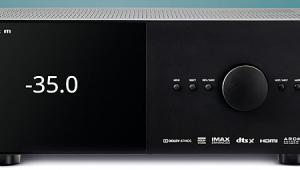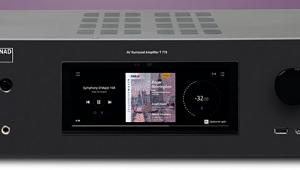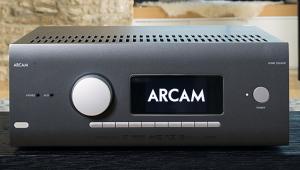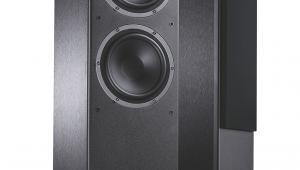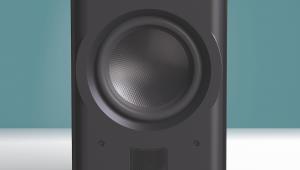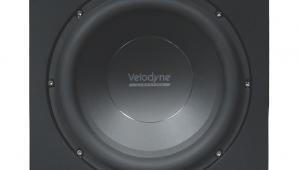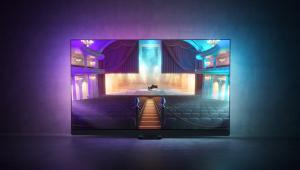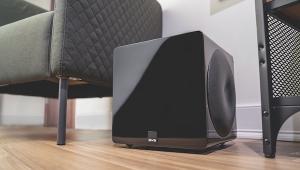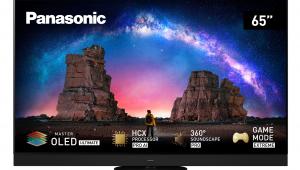Onkyo TX-NR6100 AV receiver review

 Stocked with features and an impressive multichannel performer, this AV receiver has plenty of appeal, believes Mark Craven
Stocked with features and an impressive multichannel performer, this AV receiver has plenty of appeal, believes Mark CravenThe TX-NR6100 has a feature list that appears designed to cover every base anyone buying a £799 AV receiver could wish for, from Dolby Atmos and DTS:X decoding through to an MM phono input and DAB. But, really, I wouldn't expect anything less from Onkyo.
AV enthusiasts of a certain vintage will have fond memories of the Japanese marque, as it really seemed to grab hold of the AV receiver market in the 1990s and 2000s courtesy of a series of models that introduced ideas and formats – such as THX certification and Dolby TrueHD decoding – before you knew you even wanted them. Added to this, the price points of its AVRs, from budget to flagship, were always attractive.
At the end of the 2010s, however, the wheels came off the Onkyo train, as various corporate moves – coupled to changes in the consumer electronics market – saw it cease UK distribution. It's only this year, thanks to a new ownership structure (the company, along with the Pioneer AV division it's owned since 2015, is now under the umbrella of the Premium Audio Company, also the home of brands including Klipsch and Jamo), that it's returned to the UK. And in the case of the TX-NR6100 receiver, its comeback seems to find it in business-as-usual mode. Okay, there's much about this AVR that's new over the last Onkyo model we auditioned, but the basic ethos hasn't changed. The NR6100 wants to be high-value AV.
The THX factor
The basic specification is that it's a seven-channel receiver, with THX Select certification and amplification rated
at 165W per channel. The THX badge marks it down
as meeting the organisation's criteria for a mid-sized
room (there are no THX Compact receivers, nor THX Dominus for that matter), and brings with it a suite
of features, including a trio of THX listening modes, and some bespoke tools, such as Loudness Plus, designed to maintain an effective balance between LCR and surround channel info at low listening levels.
The rated power output naturally raises eyebrows on a £799 receiver, so it's worth remembering that Onkyo chooses to measure a single channel, with a 1kHz signal, into a 6ohm load with a THD of 1%. A far more modest output can be expected in a real-word listening scenario, which in this case will typically mean a 5.1.2-channel or 7.1-channel configuration. There's no option to expand the soundfield to nine channels via external amplification. For that you'd need to look higher up the brand ladder to the TX-NR7100 (£999).
This new model's styling is reminiscent of Onkyo's receivers of the late 2010s, all purposeful right angles and front-panel controls on full display. These include a collection of somewhat old-school treble/bass/vocal tone controls, plus Movie/TV, Game and Music listening preset keys in addition to no fewer than 12 source select buttons, the latter good news for those tired of spinning a rotary dial to find the input they want.
Above this row of source buttons is a large, green-lit text display, which is traditional in the way it shows the selected source, sound format, operational speakers, etc, and is switched off when the amp is put into Pure Audio mode.
The section on listening modes in the TX-NR6100's manual runs to fifteen pages, not least because those blanket Movie, Music, Games options hide numerous sub-divisions. On offer are Orchestra, Unplugged, Game-Sports, etc, all imparting – not always agreeable – DSP. Perhaps of more interest is the amp's Stereo Assign mode, which switches two-channel playback from the front L/R speakers to height, surround or rear pairs.
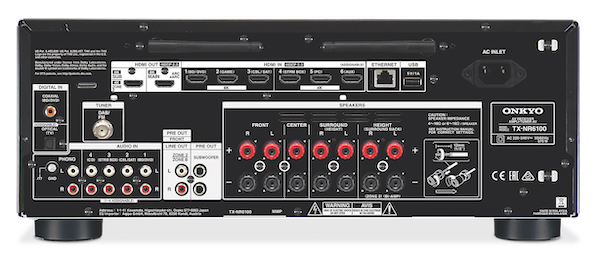
App or zap?
There's a remote control supplied with the TX-NR6100
for day-to-day operation, and this is a lightweight, rubber-keyed affair that's good for switching inputs, adjusting volume and entering the amp's onscreen menus. It's not the most intuitive zapper around, so will take some getting used to, and Onkyo's Quick Settings button would ideally overlay its adjustments on the TV/projector image, rather than have them appearing on the amp's front panel.
Slicker operation of basic functionality can be achieved via the Onkyo AV controller app, free for iOS and Android devices, but main setup is through the onscreen menus. An odd wrinkle with the amp is the Web user interface, which – if you follow the instructions in the manual – gives access to tools regards network setup. However, Onkyo pointed out to me that by logging in as a 'ciuser' it opens up the full set of adjustments. So, maybe, mention that in the manual next time?
The TX-NR6100, because it's 2023, also offers voice control through connected Amazon Alexa or Google smart speakers. These tricks are all part of what Onkyo describes as its 'Smart AV receiver' tech. Put simply, this means the receiver isn't tied into one platform, a la MusicCast or HEOS, but uses DTS Play-Fi, Chromecast (enabling network setup via the Google Home app, which is useful), AirPlay, two-way Bluetooth and other systems to cover off streaming music needs. Meanwhile, for hi-res audio lovers, the amp will playback DSD to DSD256, and PCM audio to 192kHz/24-bit, over a network or USB connection.
Wired connectivity includes coaxial and optical digital audio, dual subwoofer pre-outs, a quartet of stereo analogue audio inputs (plus the aforementioned MM phono) and six-in, two-out HDMI. Three of these HDMI inputs can pass 4K/120 and 8K/60 video, and deliver the VRR and ALLM gaming features from compatible gear. Calibration is through Onkyo's simple to use AccuEQ system, with a supplied puck-shaped microphone. There's none of the complexity or in-depth tweakery of Dirac here, not the Audyssey-style option of adding more functionality via a paid-for app. You just plug in the mic, run the test tones, and the amp does its thing. And most buyers at this price point will be happy with that – this ease of use is more a feature than a bug.
Once up and running, and with first a Polk Monitor XT Atmos system and then KEF's R Series Meta speakers in tow, it didn't take me long to notice Onkyo's receiver is quite warm-running (as many of its earlier models used to be), so giving its chassis good breathing room is recommended.
Pick a preset
For stereo music playback – a useful way to get a measure of a receiver's inherent sound – the Pure Audio or Direct modes are the purist options, with subjectively no obvious difference between the two. Interestingly, the various music modes for multichannel playout are mostly subtly different rather than exaggerated – for example, Orchestra and Unplugged are flip-a-coin similar.
Spinning a selection of tunes, from Rod Stewart's 1970s hit 'Young Turks' to the languid jazz-tinged blues of Clarence 'Gatemouth' Brown's 'Sometimes I Slip', found the Onkyo amp putting in a decent music performance for an AVR at this price. The brass instruments and gently distorted guitar on the latter sounded smoother and more tonally nuanced than I'd been expecting. But it does become clear that the amp channels struggle to dig deep into bass elements, often coming across a bit 'one-note' rather than rich and supple. As I often do with a multichannel receiver, I found listening in All-Channel Stereo mode to be a nice compromise.
This absent last ounce of bass detail with two-channel music becomes less important with the TX-NR6100's multichannel performance, where there's a subwoofer taking up a lot of the slack. And with Fast and Furious 8 (4K Blu-ray) and a 5.1.2 setup, the amplifier shows off a well-etched surround field and a quick, forceful sensibility with Foley effects. During the clown car race through the streets of Havana in the opening act, car engine sounds are thrown left and right, motorbikes wheel in and out, and the clanking, gritty detail of Dom's car falling apart piece by piece is well separated from the underlying soundtrack.
There's a feeling that it all sounds a bit safe at a low/moderate volume, but if you wind up the level the sound unfurls, the amp taking on a more aggressive nature.
With a 5.1 speaker setup, Dolby's Height Virtualizer and DTS's Virtual X processing modes are designed as sonic saviours, but the attempt at recreating a 3D sound experience from a 2D system always seems a bit disjointed. The real deal is better. When Dom's flipping car at the end of the Havana race is tracked as it flies through the air, the arc of the sound design is well conveyed.
Ice, ice baby
For the rest of the movie, the TX-NR6100 turns in an all-action performance. Gunshots, punches, crashing cars, explosions, flying submarines – everything seems to be approached with glee, the receiver showcasing pleasing dynamics (albeit not unburstable power). It has the ability to leave you feeling both suitably battered by movie effects but also impressed by a soundtrack's smaller details, such as the sound of spraying snow as Dom's Dodge Charger races across the ice in Fast & Furious 8.
While its mid-range can find plenty of tonal distinction in film scores, and dialogue isn't swamped in hectic soundmixes, I did find this receiver faltering a little with parts of the soundtrack to Prey (Disney+) where it struggled to stay smooth with some of the instruments, including the piano. At the same time, it had no trouble capturing the exquisite subtlety built into this Atmos track, taking my listening room deep into a North American forest replete with gentle effects, buzzing insects and babbling water. And with the level up high, the impact sounds when Amber Midthunder's hero practises her axe-throwing skills, plus the feeling of precise placement, was startling. Her weapon flies through the air, from the rear left of the soundfield to a dead-centre stage, and it splices bark with a sharp crack followed by a nicely decaying echo.
Up for the fight
Overall, Onkyo's TX-NR6100 is a sub-£1,000 receiver
with serious appeal. Outside of the fairly basic calibration mode it hits all the right feature points, including one or two (such as Chromecast built-in) that are minor but incredibly useful. It's also physically alluring in its broody, black guise and a responsive app makes up for a less-than-stellar remote control.
Its sound performance is on the money too. There's enough power here to satisfy its mid-sized room/speaker ambitions, and the presentation of Atmos soundmixes is well-judged, thanks to solid FX placement and separation to go with some dynamic flair. There's a lot of competition in the market, but Onkyo's AVR is ready for the fight.
HCC Verdict: 4.5/5
Onkyo TX-NR6100
Price: £799
eu.onkyo.com
We say: The seven-channel TX-NR6100 couples copious features with a lively, dynamic sound performance. Setup isn't in-depth, but few will complain at this price.
Specifications
DOLBY ATMOS: Yes DTS:X: Yes IMAX ENHANCED: No MULTICHANNEL INPUT: No MULTICHANNEL PRE-OUT: No MULTICHANNEL OUTPUT (CLAIMED): 7 x 165W (into 6ohm, one-channel driven, 1kHz, 1% THD) MULTIROOM: Zone 2 AV HDMI: Yes. 6 x inputs and 2 x outputs AV INPUTS: 2 x digital audio (1 x optical and 1 x coaxial); 4 x analogue stereo DIMENSIONS: 435(w) x 174(h) x 380(d)mm WEIGHT: 9.8kg
FEATURES: Certified THX Select; FM/AM/DAB tuner; dual subwoofer outputs; MM phono input; 6.35mm headphone; Ethernet; Wi-Fi; two-way Bluetooth; tone controls; Movie/TV, Music and Game listening presets; AccuEQ calibration; Dolby Atmos Height Virtualizer and DTS Virtual:X; Stereo Assign Mode; HDMI 2.1 on three inputs (incl. VRR and ALLM); Apple AirPlay 2; Chromecast; DTS Play-Fi; Onkyo Dynamic Audio Amplification; hi-res audio playback via network and USB to DSD256 and 192kHz/24-bit
 |
Home Cinema Choice #351 is on sale now, featuring: Samsung S95D flagship OLED TV; Ascendo loudspeakers; Pioneer VSA-LX805 AV receiver; UST projector roundup; 2024’s summer movies; Conan 4K; and more
|






